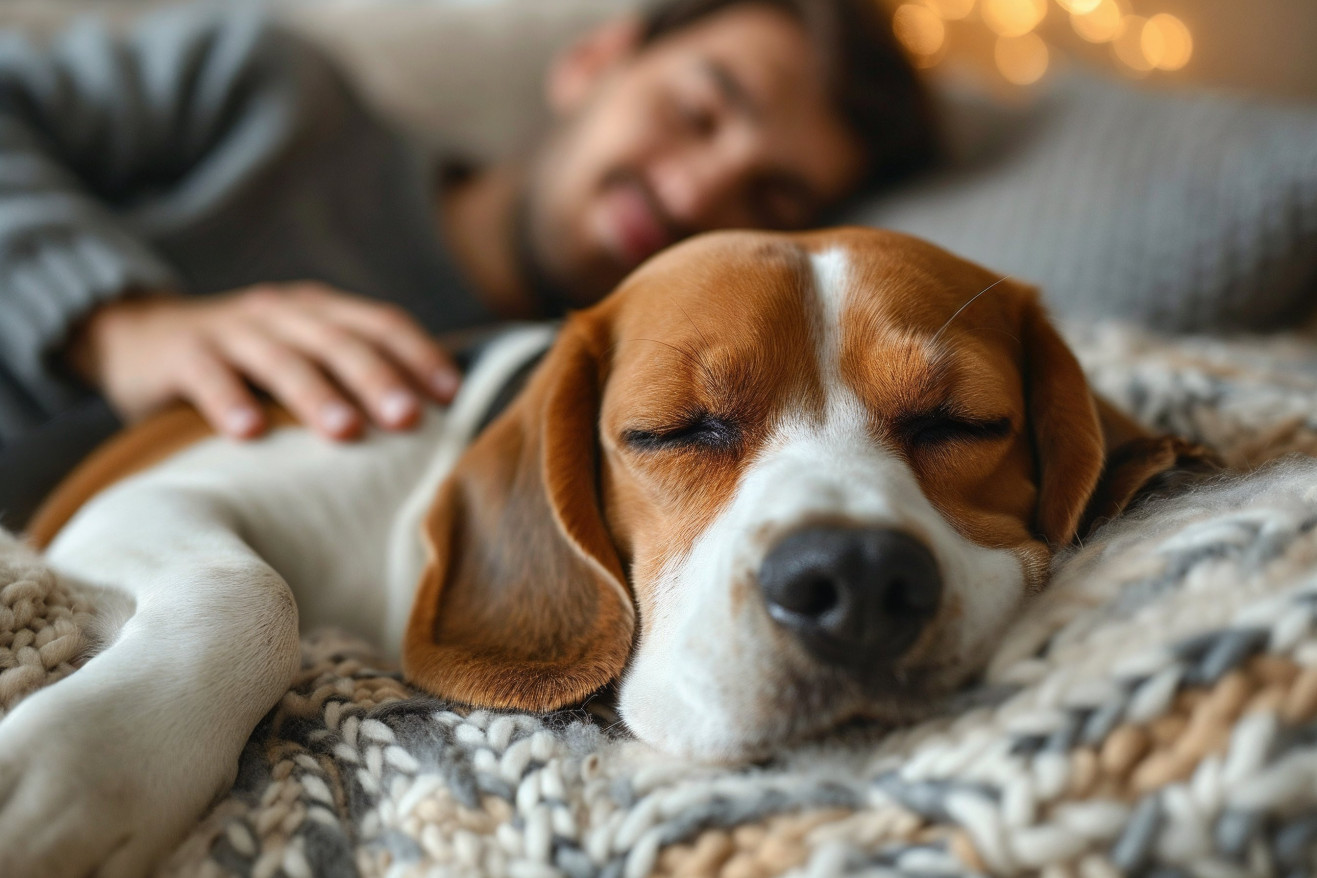Why Do Dogs Sleep with Their Bum Facing You? Decoding Canine Comfort
7 February 2024 • Updated 7 February 2024

You’ve probably seen it before: your dog sleeping with its back to you and its rear end facing you. So why do dogs sleep with their bum facing you? There are a few reasons your dog may choose this position, including to show trust and comfort, to mark you with their scent, or to take a protective stance.
However, it’s most commonly a sign that your dog feels safe and secure and can let their guard down without having to make eye contact.
This article will take a deep dive into the fascinating world of dog behavior and the science behind why dogs sleep in certain positions. It will cover research from animal behaviorists, expert commentary from veterinarians, and insights from ethological studies to help you better understand the many things that play a role in your dog’s sleeping position, from trust and comfort to scent marking and breed-specific tendencies.
Why do dogs sleep with their bum facing you?
Trust Fall: What Your Dog’s Sleeping Position Says About Your Relationship
If your dog sleeps with their back to you, it can be a sign of trust and comfort. Pet Keen explains that when dogs sleep with their backs to their owners, they are following the wild canine instinct to expose their most vulnerable area in a safe space.
The fact that your dog doesn’t feel the need to stay alert or make eye contact during this time shows that they trust you deeply and feel safe enough to turn their back to you and sleep.
Rocky Kanaka notes that dogs don’t need to sleep belly-to-belly for comfort like humans and may even find direct eye contact uncomfortable. This is further evidence that the way dogs sleep is all about feeling safe and secure with their humans.
In the same vein, Spark Paws points out that if a dog sleeps on its side, even if it’s not right next to its owner, it’s a sign that they are very comfortable and feel safe and secure in their environment.
In addition to indicating a dog’s emotional state, the way they sleep can also be a sign of their overall health and well-being. Whether they’re curled up or stretched out, the position they sleep in can show how comfortable and relaxed they are. Knowing what to look for can help you strengthen your bond with your dog and make sure they feel as safe and loved as you do.
The Science Behind Scent Marking and Dog Sleeping Positions
Dogs are known to use scent marking to claim territory and communicate with other dogs.
A study of free-ranging dogs by Simona Cafazzo found that the dogs showed a wide range of scent-marking behaviors, many of which were influenced by social and ecological factors.
In terms of sleeping positions, it’s been suggested that when a dog sleeps with its backside facing its owner, it’s a form of scent marking.
A study published in the Journal of Zoology suggested that dogs may use scent marking as an honest signal of competitive ability or, in a ‘dishonest’ manner, with smaller dogs using it to bluff about their size.
When thinking about the role scent plays in dog behavior, it’s important to remember that while urine marking is a well-known form of scent marking, the role of sleeping positions as a form of marking is less well-defined and could be a more passive, yet still personal, way of communicating and marking territory.
The Science of Sleep: How Genetics and Anatomy Impact How Dogs Sleep
The physical traits of your dog are not only what make them who they are, but they’re also some of the most important things that will determine how they sleep. Studies cited by Mirage News have shown that brachycephalic, or flat-faced, dogs like the French Bulldog have breed-specific sleep apnea, which leads to longer REM sleep phases and changes in sleep patterns.
This may mean that these dogs need to sleep in certain positions to be comfortable, like sleeping with their butt facing their owner so they can breathe more easily.
Of course, anatomical differences, including a dog’s size and shape, will naturally impact how they like to sleep. A study by Katherine A. Houpt found that while laterality in behavior is present in other activities, it doesn’t extend to sleeping position. Still, physical comfort is key, and a dog’s anatomy will determine how they like to curl up or stretch out when they’re sleeping.
Moreover, a study published in Animals found that there is a relationship between sleep quality and emotional well-being in dogs, which also suggests that the best sleep positions are probably a mix of a dog’s need for emotional security and physical comfort. This web of breed, anatomical, and emotional factors shows how complex a dog’s sleep is and how we can learn to better meet our pets’ needs.
The Impact of the Environment on Sleep
The environment in which a dog sleeps can have a big impact on the position they choose. For example, the bedding a dog sleeps on can influence the position they choose.
If the bedding is warm and comfortable, the dog is more likely to choose a position that allows them to be as comfortable as possible, like sleeping with their backside facing their owner, according to Tractive.
The temperature in the room can also play a role. If the room is cooler, the dog may choose a position that helps them conserve heat, while if the room is warmer, the dog may choose a position that helps them stay cool, even if it doesn’t involve sleeping in direct contact with their owner.
The Cummings School of Veterinary Medicine at Tufts University notes that the environment in which a dog sleeps can also impact the quality of their sleep. A consistent, secure environment can help the dog feel safe and sleep more soundly. On the other hand, changes in the environment, like a change in bedding or room temperature, can make the dog feel less secure and lead to changes in their sleep.
A study published in PMC notes that the social context, which is similar to the environment, can also impact a dog’s arousal and relaxation. This makes it important to make sure the environment in which a dog sleeps is comfortable and secure. This will help ensure the dog gets the rest they need and wakes up feeling refreshed and ready to spend another day bonding and playing.
Inside the Canine Mind: Psychological Benefits of Sleep
The way that dogs sleep can tell us a lot about their psychological needs, especially their need for security. A 2023 study by Thompson et al. in the Proceedings of the Royal Society B found that a dog’s sleep macrostructure is affected by their emotional state, both positive and negative.
This means that dogs, like humans, need to feel secure to get good sleep. When a dog sleeps with its backside to you, it may be a sign that the dog feels a secure attachment that allows them to relax and get the sleep they need.
In addition, A literature review in ScienceDirect explains that human-dog interactions activate the parasympathetic nervous system (PNS), which is responsible for relaxing the body and reducing stress. This activation likely continues into sleep, where the PNS helps dogs relax and get the rest they need.
A study published in PMC explains that the quality and type of sleep a dog gets can be a sign of their overall health, focusing on the importance of stress and security.
These studies show that a dog’s psychological state and their sleeping position are closely linked, and that a dog’s need for a secure and comfortable environment is important to their physical and psychological well-being. Learning more about the specifics of a dog’s sleep can help people better understand their emotional needs and build stronger relationships with their pets.
Unpacking the Dog Paradox: Why Do Dogs Sleep with Their Butts to You?
When you consider all of the possible reasons why a dog might sleep with their butt facing their human, it’s easy to see that this behavior is a complex combination of trust, comfort, and instinct.
For example, in addition to the idea that the position is a sign of trust, Pet Keen also points out that it may be that dogs feel comfortable enough to expose their most vulnerable side to their humans. Meanwhile, Fi suggests that dogs may use the position to mark their territory with their scent, which would be a way of claiming their humans.
The position a dog sleeps in can also be an important sign of their well-being, which underscores the importance of understanding what their sleeping positions are telling us about their physical and mental health. Whether a dog’s sleeping position is a result of breed-specific traits, physical characteristics, or the need for psychological comfort, it tells us what they need to feel safe and secure.
In the end, the sleeping positions our dogs adopt are silent but powerful reflections of our relationships with them. Knowing why a dog might sleep with their butt facing you can tell you a lot about their emotional lives and help you build a stronger bond with your furry family member.


